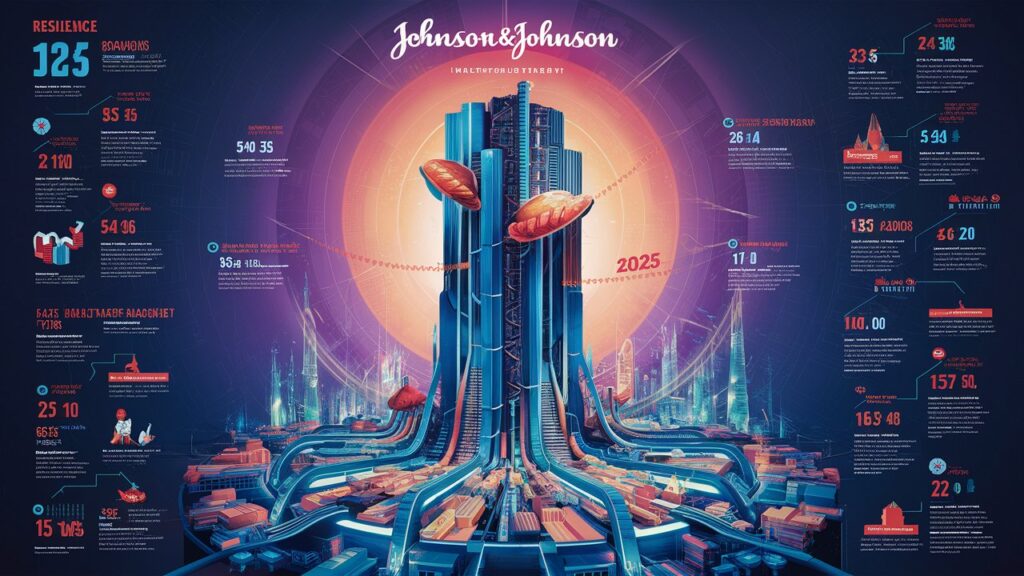Introduction: Stability in Turbulent Times
Amidst 2025’s market volatility driven by geopolitical shifts and economic uncertainty, Johnson & Johnson (NYSE: JNJ) stands out as a beacon of resilience. Trading near $152.28 with a modest year-to-date gain of 7.05% 12, JNJ exemplifies the defensive characteristics investors crave during turbulent periods. With its AAA-rated balance sheet, diversified healthcare portfolio spanning pharmaceuticals (Innovative Medicine), medical devices (MedTech), and a legendary dividend streak spanning 63 consecutive years of increases 9, JNJ offers a compelling blend of stability and strategic growth. Despite facing headwinds like biosimilar competition for blockbuster drug Stelara and lingering litigation overhangs, the company’s Q1 2025 earnings beat [$2.77 EPS vs. $2.59 estimate] and raised full-year sales guidance [$91.0B–$91.8B] signal underlying strength 911. This analysis delves into the multifaceted investment thesis for JNJ, examining its financial health, growth catalysts, risk profile, and technical positioning to determine whether this healthcare titan deserves a core allocation in modern portfolios.
1: Financial Fortitude and Recent Performance
Johnson & Johnson’s financial architecture reveals a meticulously engineered balance between growth investments and shareholder returns. Q1 2025 results showcased operational sales growth of 4.2%, climbing to $21.9 billion, fueled by robust performances in both key segments: Innovative Medicine (+2.3%) and MedTech (+2.5%) 9. More impressive was the earnings surge, with reported EPS skyrocketing 238.8% to $4.54 (though this included one-time gains), while adjusted EPS grew 2.2% to $2.77, exceeding consensus estimates by $0.18 911. Beneath the headlines, strategic shifts are bearing fruit: Oncology powerhouse drugs Darzalex and Carvykti delivered double-digit growth, partially offsetting Stelara’s -810 basis point drag from biosimilar incursions 9. The MedTech division, supercharged by the $13.1 billion Shockwave Medical acquisition, demonstrated 4.1% operational growth, with cardiovascular interventions like Abiomed driving momentum 46. Financially, JNJ maintains fortress-like metrics: $38.78 billion in cash reserves, $16.8 billion in levered free cash flow (TTM), and a manageable debt-to-equity ratio of 66.9% despite recent acquisitions 12. This liquidity fuels JNJ’s capital allocation triad: R&D investment ($3.7B in 2024), dividend growth ($5.20 annualized yield, 3.41%), and strategic M&A 39.
2: Growth Catalysts and Innovation Pipeline
Beyond current financials, Johnson & Johnson’s future hinges on a meticulously curated pipeline and strategic expansion initiatives. The company is aggressively countering Stelara’s $11 billion revenue exposure with next-generation therapies across high-need therapeutic areas:
- Oncology Dominance: Carvykti (multiple myeloma) and Rybrevant/Lazcluze (lung cancer) show accelerating adoption, with subcutaneous formulations recently approved in Europe to boost convenience 9.
- Immunology Expansion: Tremfya’s approval for Crohn’s disease in Q1 2025 unlocks a vast new patient population, while nipocalimab (Fast Track-designated for Sjögren’s disease and myasthenia gravis) represents a potential $5B+ franchise 39.
- Neuroscience Bet: The April 2025 acquisition of Intra-Cellular Therapies for $14.6 billion brings blockbuster schizophrenia/bipolar drug Caplyta, expected to contribute $700 million in 2025 sales and synergize with JNJ’s existing mental health portfolio 914.
Simultaneously, JNJ is engineering a MedTech renaissance. The clinical trial launch of the OTTAVA robotic surgery system positions it to disrupt Intuitive Surgical’s monopoly, leveraging JNJ’s surgical ecosystem 69. Electrophysiology and cardiovascular interventions—bolstered by Shockwave’s intravascular lithotripsy (IVL) technology—now constitute 50% of the segment’s portfolio, up from 18% in 2018, targeting markets growing at 5-7% annually 46. Management expects one-third of total sales to emanate from products launched within the past five years by 2027, a testament to R&D productivity ($3.7B invested in 2024) 49.
3: Risk Assessment and Mitigation Strategies
No JNJ analysis is complete without addressing the embedded risks that have pressured its valuation:
- Stelara Biosimilar Onslaught: With Europe already facing competition and U.S. exclusivity expiring, Stelara’s erosion could accelerate beyond Q1’s -810bps impact. Mitigation lies in rapid share gains for newer biologics like Tremfya and pipeline assets like icotrokinra (75% skin clearance in plaque psoriasis trials) 39.
- Litigation Overhang: Talc-related liabilities, though partially resolved via a $6.48B settlement proposal, remain a reputational and financial drag. JNJ’s $20B+ litigation reserve provides a buffer, but final resolution is critical 3.
- Operational Hiccups: The Q1 2025 pause of heart device Varipulse (neurovascular event reports) exemplifies regulatory risks in MedTech. JNJ’s decentralized structure—moving 32,000 associates into business units—aims to enhance safety agility 34.
- Macroeconomic Headwinds: Tariffs may impose ~$400 million costs in 2025, while FX volatility pressured international sales (-1.8% in Q1). Operational hedging and pricing actions partially offset these drags 914.
Table: JNJ’s Key Risk Exposure and Mitigation
| Risk Factor | Financial Impact (2025E) | Mitigation Strategy |
| Stelara Biosimilars | ~$2B–$3B sales decline | Ramp Darzalex, Carvykti, Tremfya expansion |
| Talc Litigation | Reserve-funded; reputational harm | Settlement finalization; portfolio diversification |
| MedTech Regulatory | Project delays (e.g., Varipulse) | Enhanced pharmacovigilance; OTTAVA diversification |
| Tariffs/FX | $400M+ cost impact | Price optimization; supply chain localization |
4: Dividend Reliability and Shareholder Returns
Johnson & Johnson’s dividend aristocracy status remains unshaken, with Q1 2025 marking its 63rd consecutive annual increase to $1.30 per share quarterly ($5.20 annualized) 69. This unparalleled consistency stems from the company’s recession-resistant cash flows—evidenced by its 24.42% net profit margin—and disciplined payout ratio (45–55% of earnings) 12. For income investors, JNJ’s 3.41% yield surpasses the S&P 500 average and offers real return potential amid moderating inflation. Beyond dividends, JNJ deployed $2 billion toward share repurchases in 2024’s first three quarters, providing additional EPS accretion 3. The company’s Aaa/AAA credit rating (rare among corporations) further ensures cost-efficient debt financing for strategic initiatives while safeguarding shareholder returns 4. In an era where fixed-income alternatives offer fleeting yield advantages, JNJ’s dividend growth trajectory—compounded by management’s guidance for 5.2–7.2% adjusted EPS growth in 2025—creates a compelling total return backbone 911.

5: Valuation and Technical Analysis
JNJ’s current valuation presents a paradox: discounted versus peers yet rich in quality. Trading at 16.94x TTM P/E and 14.39x forward earnings, it sits below sector peers like Merck (11.56x) and Pfizer (17.45x) 512. Its beta of 0.41 confirms minimal correlation to broader market swings, justifying a defensive premium 12. Analyst consensus reveals a $170.84 price target (19 analysts), implying 12% upside from current $152 levels, with bullish projections reaching $185 8. Technically, JNJ shares have consolidated between $140–$170 since 2022, with the Q1 2025 earnings beat catalyzing a breakout above the 200-day moving average 612. Sustained closes above $155 could trigger momentum inflows toward $165–$170 resistance. Dividend investors should note the attractive entry yield of 3.41%—historically high versus JNJ’s 10-year average of 2.7%—enhancing margin of safety 12. When combined with management’s upgraded EPS guidance ($10.50–$10.70 for 2025) and operational sales outlook ($91.6B–$92.4B), JNJ’s risk/reward appears asymmetrically positive 911.
Table: JNJ Valuation vs. Healthcare Peers (June 2025)
| Metric | JNJ | MRK (Merck) | PFE (Pfizer) | LLY (Eli Lilly) |
| P/E (TTM) | 16.94x | 11.56x | 17.45x | 64.21x |
| Forward P/E | 14.39x | 13.2x* | 12.1x* | 45.8x* |
| Dividend Yield | 3.41% | 2.4%* | 3.8%* | 0.7%* |
| Beta | 0.41 | 0.32* | 0.64* | 0.19* |
| EPS Growth (5Y) | 0.4% | 12.0% | -13.2% | 5.7% |
| *Estimates based on market data; peers not in all search results. |
6: Analyst Sentiment and Institutional Positioning
Wall Street’s view on JNJ remains cautiously optimistic, with a predominant “buy” or “hold” stance. The $170.84 average price target reflects confidence in management’s guidance execution and pipeline monetization 8. Institutional investors—particularly low-volatility seekers—have maintained exposure, evidenced by 98 hedge funds holding JNJ shares, attracted by its 0.49 equity beta and consistent cash generation 4. Short-term concerns over Stelara erosion and tariff impacts are counterbalanced by long-term bullishness around Carvykti’s multi-billion potential, nipocalimab’s blockbuster prospects, and MedTech innovation. Retail investors should note JNJ’s historical resilience during corrections: its 3-year return of 8.53% trailed the S&P 500’s 55.74%, yet it outperformed dramatically during 2022’s bear market 12. This defensive characteristic, combined with accelerating EPS growth (projected 4.63% for 2026), makes JNJ a strategic diversifier 11.
Conclusion: The Case for Strategic Patience
Johnson & Johnson embodies the quintessential “tortoise” investment—prioritizing durable competitive advantages over explosive growth. While 2025 brings palpable challenges from Stelara biosimilars and macroeconomic turbulence, the company’s strategic pivots—towards oncology/neuroscience leadership, robotic surgery disruption, and shareholder returns—position it for sustainable mid-single-digit growth. For investors, JNJ offers a rare trifecta: dividend reliability (3.41% yield with 63-year growth), portfolio stability (beta 0.41), and catalysts for re-rating (nipocalimab approvals, OTTAVA trials, Carvykti expansion). Trading below intrinsic value estimates ($172 by Forbes 3) and historical multiples, JNJ warrants accumulation on dips below $150. As global healthcare consumption inexorably rises, Johnson & Johnson’s diversified engines—Innovative Medicine and MedTech—should power total returns of 9–11% annually through dividends and modest multiple expansion, proving that in markets, slow and steady often wins the race.
Frequently Asked Questions (FAQs)
Q1: What are Johnson & Johnson’s main growth drivers in 2025–2026?
JNJ’s near-term growth relies on offsetting Stelara declines with oncology drugs (Carvykti, Rybrevant), neuroscience assets (Spravato, Caplyta via acquisition), and MedTech innovations like the OTTAVA surgical robot. Pipeline candidates like nipocalimab (autoimmune diseases) and icotrokinra (psoriasis) offer long-term optionality 369.
Q2: Is Johnson & Johnson’s dividend safe?
Extremely safe. With 63 consecutive annual increases, a payout ratio below 55%, and $16.8B in annual free cash flow, JNJ’s dividend boasts AAA-backed security. Its yield of 3.41% is well-covered by earnings 6912.
Q3: What are the biggest risks facing JNJ stock in 2025?
Key risks include: Accelerated Stelara revenue erosion from biosimilars ($11B franchise), unresolved talc litigation liabilities, regulatory delays for devices like Varipulse, and tariff-related cost inflation (~$400M impact) 3914.
Q4: How did JNJ’s Q1 2025 performance impact its full-year outlook?
JNJ raised its 2025 operational sales guidance to $91.6B–$92.4B (from $90.9B–$91.7B) post-Q1 beat, reflecting Caplyta’s inclusion. Adjusted EPS guidance remains $10.50–$10.70 (6.2% growth midpoint), incorporating acquisition dilution 914.
Q5: Why is JNJ considered a low-risk stock?
Its 0.41 beta signifies minimal volatility versus the broader market. Diversified revenue streams (pharma, devices), recession-resistant demand, high cash flows, and a fortress balance sheet ($38.8B cash) reduce business risk 412.

